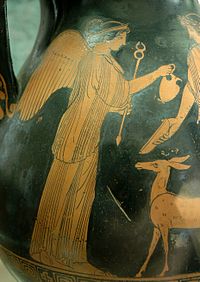Iris (mythology)



In Greek mythology, Iris (/[invalid input: 'icon']ˈaɪr[invalid input: 'ɨ']s/; Ἶρις) is the personification of the rainbow and messenger of the gods. She is also known as one of the goddesses of the sea and the sky. Iris links the gods to humanity. She travels with the speed of wind from one end of the world to the other,[1] and into the depths of the sea and the underworld.
In myths
According to Hesiod's Theogony, Iris is the daughter of Thaumas and the cloud nymph Electra. Her sisters are the Harpies; Aello, Celaeno and Ocypete.
Iris is frequently mentioned as a divine messenger in the Iliad which is attributed to Homer, but does not appear in his Odyssey, where Hermes fills that role. Like Hermes, Iris carries a caduceus or winged staff. By command of Zeus, the king of the gods, she carries an ewer of water from the River Styx, with which she puts to sleep all who perjure themselves. Goddess of sea and sky, she is also represented as supplying the clouds with the water needed to deluge the world, consistent with her identification with the rainbow.
According to Apollonius Rhodius, Iris turned back the Argonauts Zetes and Calais who had pursued the Harpies to the Strophades ('Islands of Turning'). (This eventful 'turning' may have resulted in the islands' name.[citation needed]) The brothers had driven off the monsters from their torment of the prophet Phineus, but did not kill them upon the request of Iris, who promised that Phineas would not be bothered by the Harpies again.

Iris is married to Zephyrus, who is the god of the west wind. Their son is Pothos (Nonnus, Dionysiaca). According to the Dionysiaca of Nonnos, Iris' brother is Hydaspes (book XXVI, lines 355-365).
In Euripides' play Heracles, Iris appears alongside Lyssa, cursing Heracles with the fit of madness in which he kills his three sons and his wife Megara. In some records she is a sororal twin to the Titaness Arke (arch), who flew out of the company of Olympian gods to join the Titans as their messenger goddess during the Titanomachy, making the two sisters enemy messenger goddesses. Iris was said to have golden wings, whereas Arke had iridescent ones. She is also said to travel on the rainbow while carrying messages from the gods to mortals. During the Titan War, Zeus tore Arke's iridescent wings from her and gave them as a gift to the Nereid Thetis at her wedding, who in turn gave them to her son, Achilles, who wore them on his feet. Achilles was sometimes known as podarkes (feet like [the wings of] Arke.)
Epithets
Iris had numerous poetic titles and epithets, including Chrysopteron (Golden Winged), Podas ôkea (swift footed) or Podênemos ôkea (wind-swift footed), and Thaumantias or Thaumantos (Daughter of Thaumas, Wondrous One). Under the epithet Aellopus (Ἀελλόπους) she was described as swift-footed like a storm-wind.[2] She also watered the clouds with her pitcher, obtaining the water from the sea.
Representation
Iris is represented either as a rainbow, or as a young maiden with wings on her shoulders. As a goddess, Iris is associated with communication, messages, the rainbow and new endeavors.
Derivations
In language
- The word iridescence is derived in part from the name of this goddess.
- "Arco iris" and "arco-íris" are the words for "rainbow" in Spanish and Portuguese, respectively, where "Arco" means "bow" in English.
- The iris of the eye is named after her as she was the goddess of the rainbow, to reflect the many colours of the eye.
Namesake
- The asteroid 7 Iris.
- The element Iridium.
- Iris (plant)
Artwork
- In 1946, Iris was depicted on a 50-franc airmail stamp in France. This was accompanied the same year by a 40-franc airmail stamp depicting a centaur shooting an arrow into the sky.
Fictional adaptations
- Iris appears as a character in William Shakespeare's play The Tempest (1611).
- Iris appears in the Disney movie Fantasia at the end of the segment featuring the Pastoral Symphony by Beethoven.
- Iris is a character used in the Percy Jackson and The Olympians and Heroes of Olympus series by Rick Riordan. The characters use Iris messages to communicate.
- Video games Golden Sun: The Lost Age and Lufia II: Rise of the Sinistrals include characters inspired by the goddess.
- Iris appears in the female chorus of Timberlake Wertenbaker's The Love of the Nightingale.
- Iris appears in Michael Scott's "The Secrets of the Immortal Nicholas Flamel"
See also
Notes
References
- Grimal, Pierre, The Dictionary of Classical Mythology, Wiley-Blackwell, 1996, ISBN 978-0-631-20102-1. "Iris" pp. 237–238
- Peyré, Yves, "Iris." 2009. In A Dictionary of Shakespeare's Classical Mythology (2009-), ed. Yves Peyré. http://www.shakmyth.org/myth/129/iris
- Smith, William; Dictionary of Greek and Roman Biography and Mythology, London (1873). "Iris"
External links
- Hesiod, the Homeric Hymns, and Homerica by Hesiod (English translation in the Project Gutenberg online book catalog)
- The Iliad by Homer(English translation in the Project Gutenberg online book catalog)
- The Argonautica by c. 3rd cent. B.C. Apollonius Rhodius (English translation in the Project Gutenberg online book catalog)
- Aaron Atsma, The Theoi Project: Iris Goddess of the Rainbow & Messenger of the Gods
- Greek Mythology Link by Carlos Parada, author of Genealogical guide to Greek mythology
- Ancient World Mapping Center
